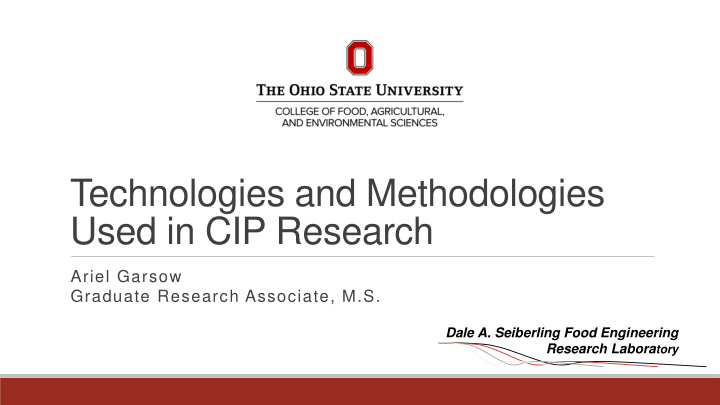



Technologies and Methodologies Used in CIP Research Ariel Garsow Graduate Research Associate, M.S. Dale A. Seiberling Food Engineering Research Labora tory
Lab History • Dale A. Seiberling • “Father of Cleaning -In- Place”, CIP • Dr. Dennis R. Heldman • Had Dale A. Seiberling as an instructor at The Ohio State Dale A. Seiberling Food Engineering Research Labora tory 2
Inside Look: CIP Cleaning Process • Fundamentals • Time, temperature, concentration, flow characteristics Pipe wall Foulant Step 1: Prerinse Production run Step 2: Alkaline Cleaning Step 3: Rinse Foulant Pipe wall 3
CIP Optimization Opportunities Cleaning 2.5 : 1 Large commercial 15 : 1 Local = High water, energy and chemical usage, long down time. = High water, energy and chemical usage, long down time Goldammer, et. Al (2008), Klemes, et. al (2008) 4
Laboratory Approach • Purpose • Methods • Conserve energy • Benchtop systems • Reduce water usage • Pilot plant equipment • Reduce cleaning agents 5
Ozone CIP Skid • Manual operation • Variable flow rate pump • Q=VA • Flow rate to velocity conversion 6
Ozone CIP Skid • Traditional CIP and Ozonated Water CIP capabilities • Generates varying concentrations of ozone 7
Biofilm Generator • 1.0” sanitary stainless steel tubing • Reynolds number for system calculated • Entrance Region 8
Pilot Plant CIP Skid • Real time Data Acquisition Software • Conductivity, resistivity, temperature, flow rate, pressure • Touch Screen Human Machine Interface, HMI • Multiple system configurations 9
Pilot Plant CIP Skid Alternative configuration pilot plant CIP System 10
Benchtop CIP Unit • Temperature controlled • Flow characteristics • Spindle • Variable velocity • Saves time Fan, et. al (2015) 6
Theoretical Considerations Computational Fluid Dynamics to create a scaleable system Fan, et. al (2015) 12
Research Methodology: Rinse Water Effectiveness NFDM HEATING Residual film% Fan, et. al (2015) 6
Scaleup of Benchtop Model • Uniform and reproducible deposit on pipe sections • Measured the influence of rinse water on removal • Temperature • Flow characteristics Fan, et. al (2015) 14
How Pilot Plant CIP Skid was used • Determined quantities of rinse water to provide effective removal of deposit 15
Results: Rinse Water Effectiveness • Increasing fluid velocities provides: • Higher mass transfer rate • Greater removal of the deposits Influence of velocity on the removal of protein deposits Fan, et. al (2015) 16
Ozonated Water CIP: What is Ozonated Water? • Ozone, (O 3 ) dissolved in water • Antimicrobial agent: 21 CFR 170.3 (o)(2) • Generally Recognized as Safe: 21 CFR 184.156 • Used as a disinfectant in drinking water treatment plants CFR (2018) 17
Ozonated Water CIP: Research Purpose • Limitations with traditional CIP • Water usage • Caustic • Environment • Ozone CIP for biofilm removal: • Step 1: Pre-rinse • Step 2: Ozonated Water 18
Research Objectives • Confirm the methods for quantification of an industrially relevant biofilm • Quantify the rate of biofilm cleaning and sanitation • Determine the influence of ozone concentration on the rate of biofilm cleaning and sanitation • Develop methods to determine the water efficiency of the ozonated CIP system 19
Use of Biofilm Generator • Mimics industrial biofilm building • 1.0” sanitary stainless steel tubing • Nominal piping chart • DIRO water added • pH, electrical conductivity, dissolved oxygen and temperature measured 20
Use of Ozone CIP Skid • Ozonated Water • 1ppm, 3ppm, 6ppm • Safety Considerations 21
Analysis of Pipe Sections • Standard Plate Count, SPC • Viable microorganisms • Colony Forming Units per cm 2 • Adenosine Triphosphate, ATP • Luminometer • Relative Light Units 22
Preliminary Results: SPC • 5.0 Ozonated Water CIP • Nearly 1.5 to 2 log Log CFU/cm 2 4.0 reduction from control 3.0 • CIP using NaOH 2.0 • Nearly 4 log reduction from control 1.0 • Reductions the biofilm 0.0 control compared to all Control 1ppm 3ppm 6ppm NaOH ozone treatments were CIP significant Condition Influence of cleaning agents on Standard Plate Count 23
Preliminary Results: ATP • 60 Similar trends to SPC Relative Light Units • 50 Ozonated water CIP 40 • Nearly 80% reduction 30 • CIP using NaOH 20 • Nearly 90% reduction 10 • Reductions from control due to all treatments were 0 significant Control 1ppm 3ppm 6ppm NaOH CIP Condition Influence of cleaning agents on adenosine triphosphate 24
How clean is clean? 25
Nanoscale Residues Changes in stainless steel surfaces as function of time during cleaning • 0.5% NaOH • 4 exposure times • Cleaning results Phinney, et. al (2017) 26
Nanoscale 27
Conclusion • Further characterization of the biofilm • Effectiveness of ozonated water as a cleaning and sanitizing agent • Different ozone concentrations and turbulences • Demonstrating the feasibility for food manufacturers to use this technology • Reduce water usage 28
Thank you! Ariel Garsow Graduate Research Associate, M.S. garsow.1@osu.edu Dale A. Seiberling Food Engineering Research Labora tory
References • ChemBam. Nanotechnology . Internet. Acccessed 12 May 2018. https://chembam.com/definitions/nanotechnology/. • Goldammer, Ted (2008). The Brewer’s Handbok . Apex Publishers. • Klemes, Jiri, Smith, Robin, Jin-Kuk, Kim (2008). Handbook for Water and Energy Management in Food Processing . Elsevier, 286-288, 724. • Lavars, Nick (2018). WHO launches health review as study finds plastic particles in 93 percent of bottled water . Internet. Accessed 12 May 2018. https://newatlas.com/microplastic-bottled-water-who/53838/. • Phinney, David M., Goode, Kylee, Fryer, Peter J., Heldman, Dennis. Bakalis, Serafim (2017). Identification of residual nano-scale foulant material on stainless steel using atomic force microscopy after clean in place. Journal of Food Engineering.
Recommend
More recommend